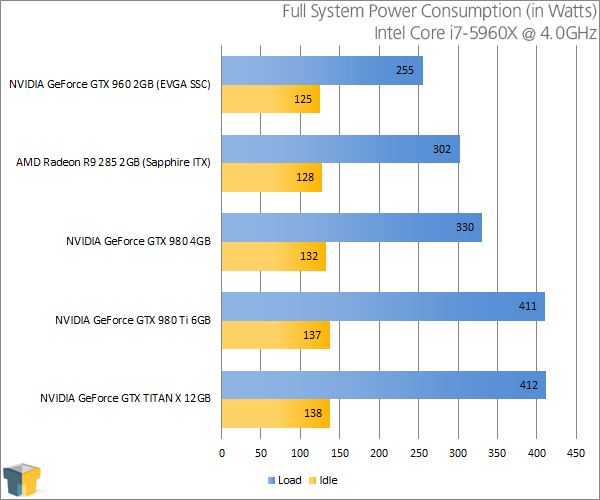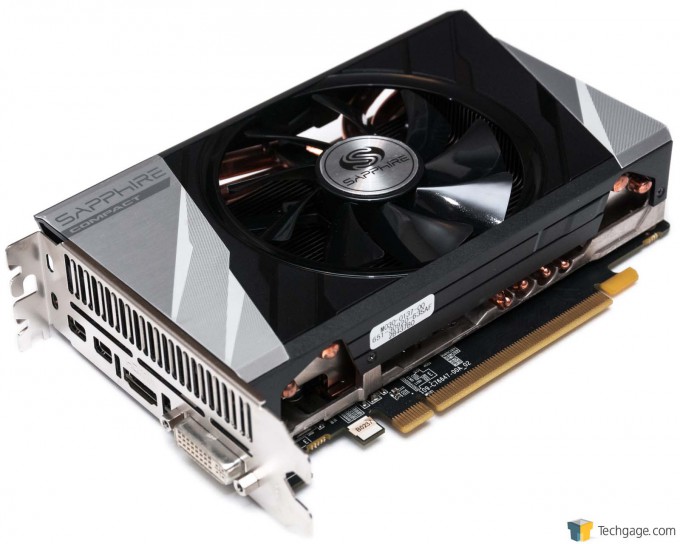- Qualcomm Launches Snapdragon 4 Gen 2 Mobile Platform
- AMD Launches Ryzen PRO 7000 Series Mobile & Desktop Platform
- Intel Launches Sleek Single-Slot Arc Pro A60 Workstation Graphics Card
- NVIDIA Announces Latest Ada Lovelace Additions: GeForce RTX 4060 Ti & RTX 4060
- Maxon Redshift With AMD Radeon GPU Rendering Support Now Available
Sapphire Radeon R9 285 ITX Compact Graphics Card Review

Finding a good graphics card for a small form-factor PC can be tough, but Sapphire helps make the decision a bit easier with a series targeting ITX builds. While we’re taking a look at the outgoing R9 285, it’s nearly identical to the R9 380, and as we find out, it’s worth a look.
Page 9 – Power & Temperatures, Final Thoughts
To test graphics cards for both their power consumption and temperature at load, we utilize a couple of different tools. On the hardware side, we use a trusty Kill-a-Watt power monitor which our GPU test machine plugs into directly. For software, we use Futuremark’s 3DMark to stress-test the card, and AIDA64 to monitor and record the temperatures.
To test, the general area around the chassis is checked with a temperature gun, with the average temperature recorded. Once that’s established, the PC is turned on and left to sit idle for ten minutes. Then we open AIDA64 along with 3DMark. We then kick-off a full suite run, and pay attention to the Kill-a-Watt when the test reaches its most intensive interval (GT 1) to get the load wattage.


The reason for the lack of comparison models is that these cards were tested in an updated platform. We pulled the trigger a little too early, expecting the 300 series to land earlier, and now are waiting until Windows 10 drops before we retest the entire fleet with an updated test suite.
Nonetheless, Sapphire’s ITX card impresses quite a bit on the temperature side, beating EVGA’s SSC GTX 960 by 8°C at load. That’s quite something given the ITX Compact’s cooler is simple in comparison, and not to mention that the card draws 47W more at peak. Color me surprised.
Final Thoughts
As I said in the intro, it might be a little odd to post a look at a last-gen card when its replacement has arrived, but, to be fair, the 300 series just came out, and the R9 380 is, in effect, the R9 285. That means if you take this card, boost its clock to match the R9 380, you’re going to see the exact same performance.
That all being said, both Sapphire’s R9 285 and R9 380 ITX Compact models look exactly the same, and have the same connectors at the back. So, my opinion on this card can also suit the 380 variant, taking into account that it’d be a bit faster. So, enough rambling, and more concluding.
The R9 285 is a good card in its own right, but I think Sapphire has done a great job of improving its appeal a lot. Who wouldn’t opt for a card that’s smaller than the rest yet keeps temperatures at modest levels? I admit that I’m not even sure how Sapphire has managed to make this card run cooler than the EVGA SSC GTX 960 with ACX 2.0 cooler – it’s almost nonsensical, but the results repeated themselves twice over.
Based on that, and the performance, this card isn’t hard to recommend. The biggest hit against it is that it draws almost 50W more at full load, when compared to the GTX 960. If that doesn’t matter to you, and you’re wanting a very capable SFF card, Sapphire’s ITX Compact is a great choice, at around ~$200. Of course, I am speaking of the R9 380 model, as this R9 285 version has doubled in price at Newegg due to the new series launch.
Now, let’s hope these ITX form-factor cards catch on.
Addendum: Sapphire notes that the R9 380 model ITX Compact has a couple of improvements under-the-hood, such as a dual-bearing fan, 16K capacitors, and black diamond chokes. Even better!
Pros
- 1080p gaming is a cakewalk. Can handle 1440p no problem with modest detail adjustments.
- Includes a simple cooler, but it’s effective.
- HDMI cable included in the box.
- Well-priced given its performance (the R9 380 is a bit better.)
Cons
- Draws ~50W more at load than GTX 960.
- Mini-DP-to-DP adapter didn’t work for me.

Sapphire Radeon R9 285 (& R9 380) ITX Compact
Support our efforts! With ad revenue at an all-time low for written websites, we're relying more than ever on reader support to help us continue putting so much effort into this type of content. You can support us by becoming a Patron, or by using our Amazon shopping affiliate links listed through our articles. Thanks for your support!






